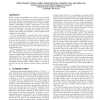42 search results - page 8 / 9 » The essence of command injection attacks in web applications |
ICSE
2008
IEEE-ACM
14 years 5 months ago
2008
IEEE-ACM
An increasing number of cyber attacks are occurring at the application layer when attackers use malicious input. These input validation vulnerabilities can be exploited by (among ...
SP
2009
IEEE
13 years 11 months ago
2009
IEEE
Providing online access to sensitive data makes web servers lucrative targets for attackers. A compromise of any of the web server’s scripts, applications, or operating system c...
ACSAC
2004
IEEE
13 years 8 months ago
2004
IEEE
Buffer overflow vulnerabilities are caused by programming errors that allow an attacker to cause the program to write beyond the bounds of an allocated memory block to corrupt oth...
WSC
2004
13 years 6 months ago
2004
Supervisory Control And Data Acquisition (SCADA) systems gather and analyze data for real-time control. SCADA systems are used extensively, in applications such as electrical powe...
CCS
2011
ACM
12 years 5 months ago
2011
ACM
The complexity of modern web applications makes it difficult for developers to fully understand the security implications of their code. Attackers exploit the resulting security v...

